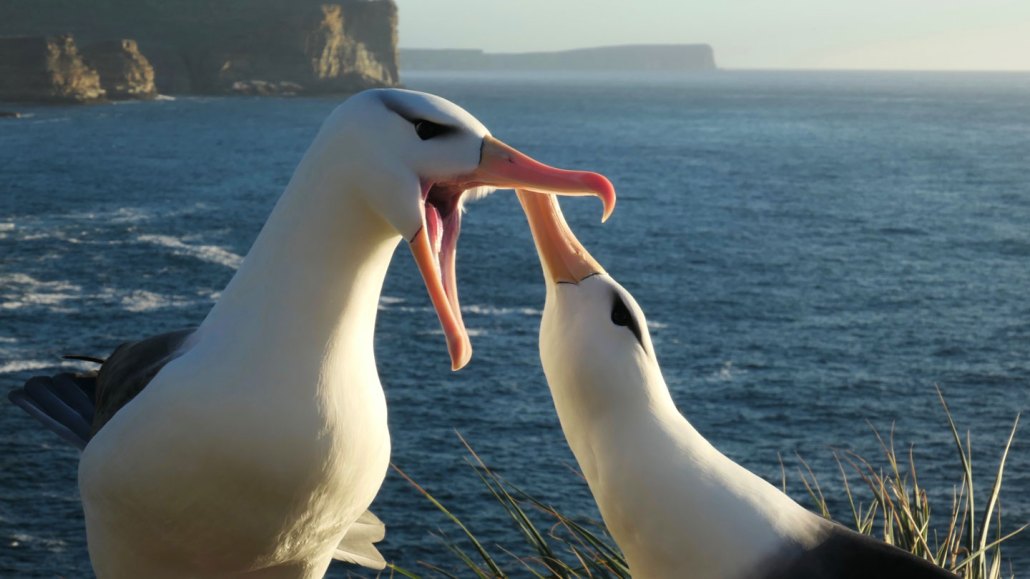
Albatrosses are famous for pairing for life, but new evidence shows that breeding success isn’t always enough to keep some of the birds together.
F. Ventura
- More than 2 years ago
When it comes to fidelity, birds fit the bill: Over 90 percent of all bird species are monogamous and — mostly — stay faithful, perhaps none more famously than the majestic albatross. Albatross couples rarely separate, sticking with the same breeding partner year after year. But when ocean waters are warmer than average, more of the birds split up, a new study finds.
In years when the water was warmer than usual, the divorce rate — typically less than 4 percent on average — rose to nearly 8 percent among albatrosses in part of the Falkland Islands, researchers report November 24 in Proceedings of the Royal Society B. It’s the first evidence that the environment, not just breeding failure, affects divorce in wild birds. In fact, the team found that during warmer years, even some females that had bred successfully ditched their partners.
The result suggests that as the climate changes as a result of human activity, higher instances of divorce in albatrosses and perhaps other socially monogamous animals may be “an overlooked consequence,” the researchers write.
Albatrosses can live for decades, sometimes spending years out on the ocean searching for food and returning to land only to breed. Pairs that stay together have the benefits of familiarity and improved coordination, which help when raising young. This stability is particularly important in dynamic, marine environments, says Francesco Ventura, a conservation biologist at the University of Lisbon in Portugal.
But if breeding doesn’t work out, many birds — mostly females — leave their partner and try to find better luck elsewhere (SN: 3/7/98). Breeding is more likely to fail in years with more difficult conditions, with knock-on effects on divorce rates the following years. Ventura wanted to find out whether the environment also has a direct impact: changing the rate of divorce regardless of whether the breeding had gone well.
Ventura and his team analyzed data collected from 2004 to 2019 on a large colony of black-browed albatrosses (Thalassarche melanophris) living on New Island in the Falkland Islands. The team recorded nearly 2,900 breeding attempts in 424 females, and tracked bird breakups. Then, accounting for previous breeding success in individual pairs, the researchers checked to see if environmental conditions had any noticeable further impact on pairings.
Breeding failure, especially early on, was still the main factor behind a divorce: Each female lays just a single egg, and those birds whose eggs didn’t hatch were over five times as likely to separate from their partners as those who succeeded, or those whose hatched chicks didn’t survive. In some years, the divorce rate was lower than 1 percent.
Yet this rate increased in line with average water temperatures, reaching a maximum of 7.7 percent in 2017 when waters were the warmest. The team’s calculations revealed that the probability of divorce was correlated with rising temperatures. And surprisingly, females in successful breeding pairs were more likely to be affected by the harsher environment than males or females that either didn’t breed, or failed. When ocean temperatures dropped again in 2018 and 2019, so did divorce rates.
Warmer water means fewer nutrients, so some birds may be fueling up out at sea for longer, delaying their return to the colony or turning up bedraggled and unappealing. If members of pairs return at different times, this can lead to breakups (SN: 10/6/04).
What’s more, worse conditions one year might raise stress-related hormones in the birds too, which can affect mate choice. A bird may incorrectly attribute its stress to its partner, rather than the harsher environment, and separate even if hatching was successful, the researchers speculate.
Such misreading between cues and reality could make separation a less-effective behavior, suggests Antica Culina, an evolutionary ecologist at the Netherlands Institute of Ecology in Wageningen who was not involved in the study. If animals divorce for the wrong reason and do worse the following season, that can lead to lower breeding success overall and possibly population decline.
Similar patterns could be found in other socially monogamous animals, including mammals, the researchers suggest. “If you imagine a population with a very low number of breeding pairs … this might have much more serious repercussions,” Ventura says.






